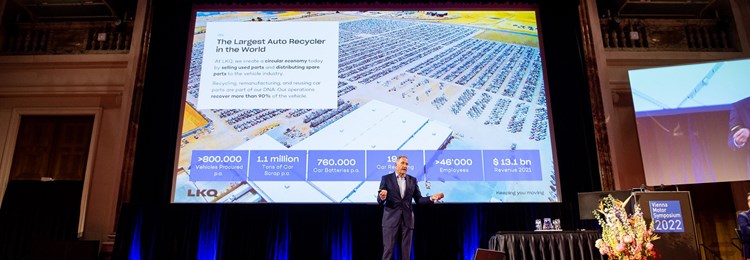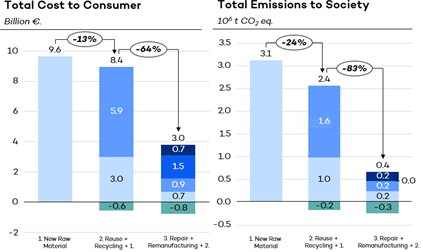
LKQ expects major savings in cost and CO2 from traction battery repair and remanufacturing
Date: Wednesday 04 May 2022
At the 43rd International Vienna Motor Symposium, the Chair “Production Engineering of E-Mobility Components” (PEM) of RWTH Aachen University, Germany, and LKQ Europe presented their investigation on challenges of traction batteries that occur over time and usage, like failures of components and battery degradation. They evaluate benefits, the cost, and emission reduction by a circular ecosystem. The future-looking project focuses on resource conservation, protection of the residual value of battery-electric vehicles, and extending the lifetime of the battery to keep the vehicle on the road with good performance.
“E-mobility is picking up speed – and must be careful not to overtake its own sustainability claim in the process. The volume of lithium-ion batteries in the last stage of their life in electric vehicles will increase massively in the coming years,” says Professor Achim Kampker, founder and head of the PEM chair of RWTH Aachen University. “Therefore, we need to develop economical and sustainable concepts for the optimization and reuse of batteries – and at the very end also for the recovery of raw materials.”
Arnd Franz, CEO of LKQ Europe:
“We want to be first to market in electrification in the Independent Aftermarket. Our cooperation with RWTH Aachen University is a crucial part of our strategy to offer diagnostics, reverse logistics, repair, and recycling of traction batteries. As the largest vehicle recycler, LKQ is expanding its life cycle solutions for electric vehicles rapidly.”
The study focuses on critical elements and potential solutions in the value chain. A fully closed loop shows the highest savings in cost and minimizes CO2 emissions, stressing the importance of battery repair and remanufacturing. Recycling of raw materials remains important, but should only be considered as a last resort.
The traction battery is the most valuable part of a battery-electric vehicle, and it is expected to last 10-14 years before it needs to be replaced. At that point, today, a non-closed battery loop is still present in many situations, leading to material waste and costly disposal. But scarcity in raw material supply, emission reduction goals, and cost considerations call for sustainable long-term solutions. End-of-life as well as defective BEV batteries should be processed in a closed-loop system. With the current sharp rise of electrification in the automotive sector, the European automotive value chain is at the dawn of a major transition. LKQ expects a steep increase in battery-electric vehicles in the Independent Aftermarket starting from 2028 when a substantial number of BEVs come out of manufacturer warranty and enter the independent workshops.
“We expect around 34 million installed high-voltage batteries in the battery-electric vehicle fleet in Europe by 2030,” states Christoph Schön, E-Mobility Innovation Manager at LKQ Europe. “The question is, how long will these batteries be intact? According to current estimates, by the end of the decade, about 1.3 million batteries per year will come back from the road due to electrical, mechanical, and electrochemical failures and will need to be diagnosed and then repaired or replaced. After that, we expect these returns to continue to increase at a rate of 30 percent per year. If the entire battery system needs to be replaced, this work is expensive. We want to have suitable and sustainable solutions on offer, where the driver of an electric car doesn’t need to invest in a new battery for a 10-year-old vehicle but can get a battery repair or refurbishment for a fraction of the cost.”
As a key enabler of a circular economy in the automotive sector, LKQ’s goal is to provide solutions for the challenges of the workshop of the future. Also, vehicle and battery manufacturers need to take design for disassembly into account at an early stage in their product development processes to reach scale in repair and remanufacturing later on. Finally, policymakers are required to provide an open and competitive framework, allowing non-discriminatory access to battery interfaces for the Aftermarket to enable service and repair.

